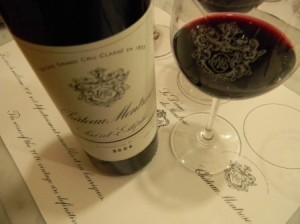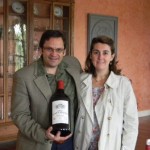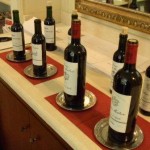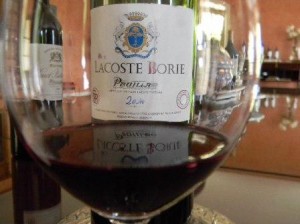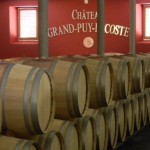Montrose, GPL and more: final notes from Vinexpo 2011
September 10, 2011
I am listening to Strange Magic by the 1970s arena pop band Electric Light Orchestra, known for its saccharine if endearing pop. It certainly makes me nostalgic for soft focus non-digital movies from the 1970s. Heaven Can Wait, anyone? With Warren Beatty and the stunningly beautiful Julie Christie… When movies were based more on dialogue than on action. Generally speaking. Of course one does come across a great exception, such as The King’s Speech, but I digress. Point being, Bordeaux is a nostalgic place, too. I recall dancing with fellow writer Jane Anson during Vinexpo in 2009 at Chateau d’Issan. To mark the end of Vinexpo, we were at the Fete de la Fleur, fireworks in the air, dancing hacks and winemakers and plenty of wine and cigars. Jane and I joked that it was like the Eagles’ Hotel California: you can check in anytime you like but you can never leave. Again, a classic 70s tune. Well, what I mean is, that the mild slope topography of the Medoc will never change too much, that the charming, UNESCO heritage site landscape of St Emilion and the understated charm of Pomerol will also remain as they are… Even though the wines have gotten bigger and richer – generally speaking – and certainly (far) more expensive, there is something lovely about Bordeaux. I hope they never take the old road sign down that welcomes visitors to St Julien. They should not replace it with some new fancy shmancy one… Would not be good for my nostalgia.
So here, I add my final notes on wines tasted during and just after Vinexpo 2011. I got a chance to re-taste Grand Puy Lacoste, especially after all the fuss created by Neal Martin, who praised it more than certain first growths in 2010. Was it that good? Well, I did not bother to sample Latour this year, being sick of their Fort Knox like attitude. But I do not think GPL measures up quite to Lafite. Still, the 2010 is a superb wine. I also sampled the Montrose 2009, again, because I have three bottles waiting for me, and I wanted to taste it again (along with the 2010). Perhaps most interesting, a tasting at several underrated properties in the Medoc, properties which are getting better and actually represent bargains for Bordeaux hunters…
Here the notes, starting with the Mighty Montrose …
First off, tasting Chateau Montrose 2009 and 2010 confirms my general feeling that 2009 is going to be a more pleasing vintage. Yes, 2010 may have more evident structure and could last longer, but 2009 pleases your senses more evidently, and it also has structure. Please keep in mind that I am talking about the left bank in general, because too many right bankers, especially in St Emilion, are marred by top heavy big and alcoholic Merlot. This is a problem. Not so on the left bank. Take Leoville Las Cases 2009, a wine that is spherical and yet rich, a wine that will last a long time and display a superb spinal column but also endear you with richness and pleasure. A wine with the power of a 1986 but with the charm and seductiveness of a 1990. The 2010 is harder to appreciate, but it will be great, too. Just not as pleasurable – methinks – as the 2009. And the same holds true for Montrose.
Montrose 2009. No press wine needed, the free run was already concentrated enough, remarked cellar master Laurent Savovitch-Vuk. He thinks it is more balanced than the somewhat comparable 2003, a wine which I had also purchased (the more torrid 2003 vintage did well in the colder soils of the northern Medoc). At 13.7 alcohol, quite high, but not touching 14… A respectable pH of 3.4, so fine balancing acidity, and it tastes that way, revealing licorice and mineral aspects with a certain softness for a St Estephe, it has actually toned itself down since the barrel tasting last year. What I like most is the freshness that this wine exudes. The palate is opulent, with a rounded mid palate, but very tannic and foreboding on the finish, which is not drying. “Rather perfect,” Laurent allowed. I am inclined to agree. 94-97
Montrose 2010. Some increase in Merlot since Montrose had purchased 22 hectares of vines from Phelan Segur, two-thirds of which is Merlot planted. I get a freshness and seriousness from this wine, and Laurent compares it to the 2005. Still, I found this one more austere than the 2009, with a steely aspect that certainly reflects St Estephe tradition, but will it ever prove as pleasing as the 2009? Yes, with time, the wine will open up and impress many a palate. 93-95+
Re-tasting the second wines, I became convinced that they dropped the ball with the Dame de Montrose 2009, with far too much Merlot (80%). Yes, the nose is flattering, with spice, and the palate is round, but where is the seriousness of a St Estephe? The Dame in 2010 is the other extreme: very smooth entry, with a certain intensity on the mid palate, but then – wham! – mouth-puckering tannin on the finish that made me reach for the water, and I could not help but detect just a hint of green.
Montrose terroir: check out the added plots of vines to Chateau Montrose purchased from Chateau Phelan Segur.
During Vinexpo at the actual trade grounds, I also ran across the Montrose 2008, which was very fine. I was a tad surprised given the summer weather, but I suppose the warmer than most people thought July worked for the Cabernet. In short, Montrose in 2008 is worth seeking out, as long as the price remains somewhat modest. The Montrose 2000, which I also tasted, was in a bit of a closed funk. And I could detect just a hint of brett… Which kind of annoyed me, because I have 6 bottles of the 2000, so highly praised by many critics – and a wine I also adored en primeur, tasted at Vinexpo 10 years earlier. I loved its tannic grain. Well, cross your fingers and hope that it is just a closed down wine. ??
The lovely surprise for budget conscious consumers like me: Chateau Tronquoy Lalande. And here the 2010 is superb, with some 50% Cabernet Sauvignon, 40% Merlot and 10% Petit Verdot – and 14.1% alcohol – the wine exudes a spicy elegance, with spearmint and excellent focus on the palate, hints of dark chocolate, fine tannic grain… Well, well, well. This is a 2010 cru bourgeois to seek!
The 2009, with almost 20% Petit Verdot, has a more traditional, somewhat tough St Estephe aspect, although it also has warmth and richness. It just seems a tad closed. Not sure how it will develop, but it does not seem to have the same focus as its younger sibling.
Château Grand Puy Lacoste: a superb Pauillac. OK, its prices have headed north, but not nearly as high as, say, Lynch Bages, and the two are comparable. When I tasted an entire lineup of Pauillac fifth growths blind for an article in Decanter, GPL stood tall… as it usually does. To me, it is like a Latour for people who cannot afford Latour. For people like me. Not as sumptuous perhaps as Lynch Bages, which is compared to Mouton (a Poor Man’s Mouton goes the adage), but just as seriously juicy and delicious, with added structure. In short, a great wine.
It is always a pleasure to taste at Chateau Grand Puy Lacoste, and this 24 June 2011 was no exception. How good is Grand Puy Lacoste 2010? Darn good. It displays cherry notes and something vivacious on the nose, followed through on the fresh palate, that manages opulence and elegance and verve. In short, the very high amount of Cabernet here – 83% – has reached optimal maturity and shows us, yet again, why the left bank can profit from the hot, dry weather. Cabernet is hard to over-ripen, as opposed to Merlot.
And if that is not enough, one can find much pleasure with the second wine, Lacoste-Borie 2010, which is also crisp and fresh on the attack, with a rather floral aspect overall. One of the best second wines in 2010. GPL easily gets 92-95+ points if we must give out points, while Lacoste-Borie gets 91-93.
We also tried the 2008 vintage, and GPL 2008 shines here, too, although not as brilliantly as it does in 2010. Some 2008s are really worth the money and GPL can join the ranks of wines like Pichon Baron and Comtesse in Pauillac, where the wine costs far less than in star vintages like 2009 or 2010 or 2005 for that matter… and yet you get a fine wine.
Here, graphite and cassis, a very opulent nose, the attack is fresh, medium intensity, with a tannic and tonic finish, not drying, but present. 91-93. Here the second wine is not as impressive, displaying some iron like notes, even a touch of animal (already?), and the palate is of medium intensity, with a slightly pinched finish.
Being at Vinexpo, one can sometimes come across lovely surprises. One such surprise was La Renaissance des Appellations, where in Bordeaux I got a chance to taste wines from other regions. Here some highlights:
Alsace
Both Domaine Josmeyer Brand Riesling GC and Hengst GC are superb in 2009. Fine precision and ripeness in both. The Hengst is perhaps larger scaled. A fine showing also from the Les Pierrets Riesling 2007.
Domaine Ostertag Fronholz Riesling 2009 displays a spicy mint like nose, fine lime notes on the palate, with precision and freshness. For €23 retail, a nice price for a quality wine. At €32, the Muenchberg GC 2009 displays more intensity, rich and full bodied.
Burgundy
Comte Armand Volnay 2009. Lovely perfume and the palate has plenty of juiciness as well as richness. Not the most complex Burgundy, but delicious. A wine to buy because not as expensive as, say, the Clos des Epeneaux 1er Cru Pommard, but providing more bang for your buck.
Domaine Leflaive Puligny Montrachet 2008. No surprises here, very good precision, linear and tasty for a villages wine…. Lovely! And then the premier crus are gorgeous, including a richer Clavoillon, yet now tight as a drum, and a far more opulent Les Pucelles, with citrus (grapefruit) aspects, more evident minerality, and also rather tight – it is young!
Finally, thanks to Laure Pradel of Lettres de Chateaux I visited Chateau Pedesclaux for the first time ever. I have tried this wine and been disappointed but efforts have been underway to improve what one blogger called Chateau Pedestrian… Indeed, until 2009, “everything here was done on the cheap,” said Vincent Bache-Gabrielsen, who directs the estate along with Chateau Lilian Ladouys in St Estephe. Until 2009, the harvest was done by machine… hardly worthy of a classed growth. Now I recall writing attention grabbing headlines for the 2005 harvest, when the owners decided to pick ultra late for ultra ripe grapes. I get a sense that they still do. But there has been a noticeable improvement: better to run the risk of over-ripeness than to have all too evident green in your wine, no? And since 50% of the vineyard is planted in Cabernet Sauvignon, there is only so much over-ripe Merlot that they can put into the mix. As impressed as I was with the improvement at Pedesclaux (the 2005 was rather bland in comparison to the 2009 and 2010), the real winner from change is Lilian Ladouys, a wine I disliked on several occasions when purchased at French supermarkets for its green tones and general insipid qualities. But recent vintages show marked improvement – and a bright future. Thanks to Laure, I tasted many other wines under the same ownership since 2009, the Lorenzetti Family. Some of these wines were good, others less so, so I include brief notes as well for these others.
Chateau Pedesclaux 2010. Nice nose, rather deep. Palate is bright, if a tad drying. I recall consulting enologist Christophe Coupez telling me how he likes to pick very late. 60% new oak barrels for 50% Cabernet and 45% Merlot and the rest Cabernet Franc. Some malolactic in new barrels. The initial attack is of medium intensity, with a certain tonicity, but I get a bit of oak derivation on the nose and palate. When tasted in reverse order, the freshness was more present, this may be the finest vintage of Pedesclaux in recent history. 89-91
Chateau Pedesclaux 2009. Just bottled. A late picking of Merlot in a rather hot vintage (30 September!) with 13 October pickings of Cabernet Sauvignon. Same blend as in 2010, same new oak percentage. Slightly higher alcohol (13.62% as opposed to 13.5% for the 2010), with lower acidity (3.2 grams per liter as opposed to 3.6 in 2010). The nose is inviting, and the palate is rich, but it lacks a certain spine. Having just tasted Grand Puy Lacoste, a fifth growth that resembles a smaller scaled Latour, this wine is far less impressive… It is good, but there is a long way to go, and I think already the 2010 shows marked improvement over the 2009. “We started with a blank sheet of paper,” Vincent remarked about the 2009 harvest –the first one done manually. Much work is to be done in terms of defining parcels and replanting, he added. Give this time in bottle, potential for higher score. 87-89
Chateau Lilian Ladouys 2010. Here we have a 60% Cab and 40% Merlot mix reaching 14% alcohol but with good balancing acidity at 3.7 grams per liter. The fresh nose precedes a somewhat tight but sap filled palate, displaying moderate finesse as well. This is a far cry from the mediocre wines that had been made here before. 90-92
Chateau Lilian Ladouys 2009. Not as impressive as the 2010, this has a more choppy palate but displays fine cedar aromatics, and a moderate intensity on the palate, with some foreboding tannins. The overall impression is of a wine that is not quite balanced but provides some pleasure from a ripe vintage. Somewhat drying on the finish. 88-89
Chateau Lilian Ladouys 2008. Vincent did not want me to try the 2005 because it was “frankly not interesting” and here we have a surprisingly strong showing of a wine that shows a smooth body, and good sap on the palate, more balanced than the 2009 in fact! The nose displays a certain nougat like sweetness but not overdone. Overall, a success. 90+

